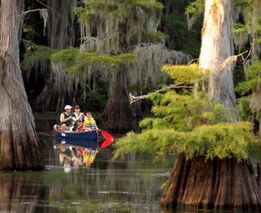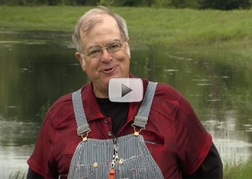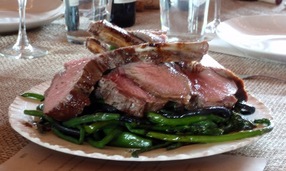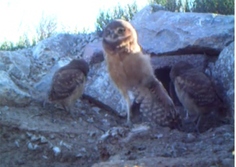In This Issue:
BOATING

Do you enjoy canoeing, kayaking or stand up paddle boarding? Maybe you’ve never done a paddle sport but would like to try one. This is an ideal time to build your skills because Texas waterways are on the mend after years of drought. Wondering where to go? Just pick one of the 68 official Texas paddling trails that appeals to you!
There are a variety of freshwater and saltwater trails located throughout the state. All are mapped and marked for your paddling pleasure. You’ll need to bring your own boat or rent one nearby, and rentals include life jackets. Speaking of safety, we've got some tips to help you build your confidence on the water.
If you’re a newbie, do read those safety tips, then watch this one-minute video on how to paddle a canoe. Are you an adventurer? Paddling is a way to explore areas unreachable by foot. Are you into fishing? Check each trail’s website to learn not only about the fishing, but also its wildlife, ecology, history and more. Let’s revel in all this water while we can. And hey - don’t forget to wear that life jacket!
|
Back to Top
WILDLIFE

The Great Texas Wildlife Trails are paths of adventure, you never know what you might find. Each trail is a marked driving loop with specific sites where you can park and get into nature. Walking through forest on the Prairies and Pineywoods Trail you may sight flying squirrels. Driving the Heart of Texas Trail might put you in the midst of migrating monarchs. And there's a cornucopia of birds on Coastal trails this time of year.
Maps are available for all nine trails, both online and as beautifully illustrated hard copies:
Included is a list of the flora and fauna you can find at each site. Now that nature has turned down the heat, the wildlife is more active and there’s no better time to explore the outdoors. Go for it! And if you drive all 9 trails, you’ll have bragging rights to an authentic Texas experience that every nature lover will envy.
|
Back to Top
LAND & WATER
 We all have a stake in what happens on privately-owned agricultural land. It affects our air, our water and our state's wildlife. So, we appreciate it when landowners practice conservation. The Leopold Conservation Award is the state’s highest honor for private land conservation. This year’s winner is Dr. Robert McFarlane, who restored 7,000 acres of bottomland hardwood habitat in East Texas. We all have a stake in what happens on privately-owned agricultural land. It affects our air, our water and our state's wildlife. So, we appreciate it when landowners practice conservation. The Leopold Conservation Award is the state’s highest honor for private land conservation. This year’s winner is Dr. Robert McFarlane, who restored 7,000 acres of bottomland hardwood habitat in East Texas.
Dr. McFarlane spent his youth hunting and fishing along the Trinity River. He left for medical school at Harvard and when he returned, the pristine land he loved had changed into fragmented pasture and farmland. In 1995 he began purchasing and restoring this land and named it The BigWoods on the Trinity. Now he is determined to show that you can manage East Texas bottomland hardwoods as a business and conserve it for wildlife. Meet this remarkable (and humorous) man in this video.
The Leopold Conservation Award, presented in association with the Sand County Foundation, is given as part of the Lone Star Land Steward Awards, which recognize private landowners for excellence in habitat management and wildlife conservation. If you’d like to nominate a landowner, this year’s deadline is November 30.
|
Back to Top
HUNTING

The local food movement embraces foods grown nearby because they’re considered fresher, healthier and more eco-friendly than typical supermarket fare. And we’re not just talking produce. The meat of regional game makes the ultimate addition to any local foods menu.
Texans can be seen as early adaptors of this trend because we have a long hunting heritage, with 95% of hunters eating the game they take. Today’s new breed of “urban hunter” carries on that tradition by hunting as a means to put local food on the table.
If you’d like to start hunting for your own food, it’s a good year for it - the hunting forecast is spectacular. If you have questions, we’ve got a bounty of information on hunting that will clue you in on places to hunt, wildlife information, regulations and more.
Do you need wild game recipes? We have wild game recipes! Texas Parks & Wildlife magazine just published a lush spread of recipes by pro chefs, including Venison Steaks with Juniper and Thyme Pan Sauce. Intrigued? We’ve also got wild game cooking demos on YouTube that are a foodie’s delight. Source your meat locally and join the Texans that have been harvesting and serving wild game for generations.
|
Back to Top
WILDLIFE

Quiz: what bird matches this description:
- the tallest bird in North America
- there’s only one wild flock left in the world
- Texas is its winter home
Answer: the whooping crane. From a low of 16 birds, conservation efforts have brought their numbers up to around 300, but they still need our help.
Whoopers are expanding their wintering grounds from the coast to other areas of Texas; and they may also be stopping to rest in new places during their migration. We’d like to know if any hazards to whoopers exist at these sites and learn more about their behavior. So, if you see any whooping cranes, please report it to: whoopingcranes@tpwd.texas.gov or 512-389-8999. Check out bird look-alikes and this checklist to help I.D. the real deal. Whoopers may begin showing up as early as this month. Follow us on Facebook or Twitter to learn when the first arrivals are sighted.
We keep tabs on them by tracking, and this short video shows an amusing effort to equip one with a tracking device. It’s a privilege to have these extraordinary birds living among us. With our help, they’ll be around for a long time to come.
|
Back to Top
LAW ENFORCEMENT

You’ll laugh, you’ll cry, you’ll wonder, “What the heck are they thinking?!” It’s time for Game Warden Field Notes.
This issue: a boat is suddenly engulfed in fire at a lake concert, marijuana is found hidden in a drug test container, a stolen boat is discovered on Craigslist and more. Texas Game Wardens are ready for anything as they investigate crime while protecting Texas’ natural resources. You can keep up with them on Facebook and Twitter.
|
Back to Top
SOCIAL MEDIA
 The El Paso Urban Wildlife Facebook page brings us this cute video of a Texas owl who appears to be demonstrating a new yoga pose for its chicks. Dubbed the “burrowing owl pose,” folks at Texas Parks and Wildlife have tried it out and advise practitioners: “Don’t forget to squawk at the end.” The El Paso Urban Wildlife Facebook page brings us this cute video of a Texas owl who appears to be demonstrating a new yoga pose for its chicks. Dubbed the “burrowing owl pose,” folks at Texas Parks and Wildlife have tried it out and advise practitioners: “Don’t forget to squawk at the end.”
|
 This issue’s YouTube pick is about the high number of bobcats living in urban areas. See how these native wildcats have learned to coexist peacefully with humans. This video is a segment from the Texas Parks & Wildlife TV series, which is broadcast on PBS across Texas, Oklahoma and parts of New Mexico. Check your local PBS station for listings. This issue’s YouTube pick is about the high number of bobcats living in urban areas. See how these native wildcats have learned to coexist peacefully with humans. This video is a segment from the Texas Parks & Wildlife TV series, which is broadcast on PBS across Texas, Oklahoma and parts of New Mexico. Check your local PBS station for listings.
|
Back to Top
The average whooping crane is 5 feet tall, has a 7 ½ foot wingspan and weighs only 15 pounds.
Thanks to the following sponsors and partners:
|